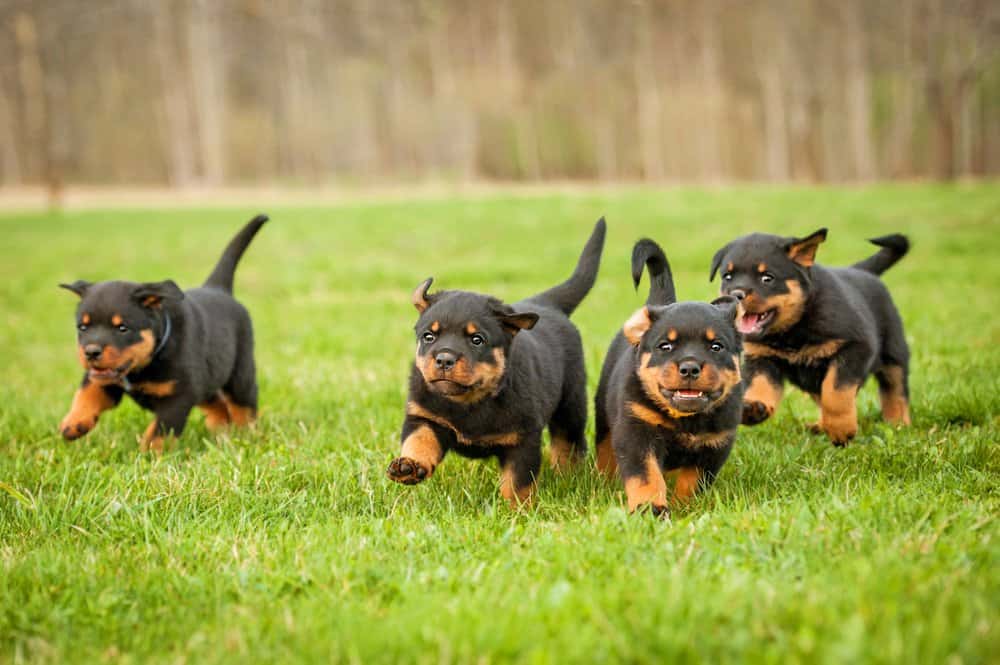When your dog gets pregnant, it can be a very exciting time. However, pregnancy can also be a stressful time. There are many possible complications, and your dame will need special care during this period.
Whether you purposefully bred your Rottweiler or not, it’s your responsibility to take care of her during her transition to motherhood. We’re here to help you do just that.
Below, you’ll find the most comprehensive guide to Rottweiler pregnancy available. We’ll discuss pregnancy symptoms, how to care for your dog, what to expect every week, and more.
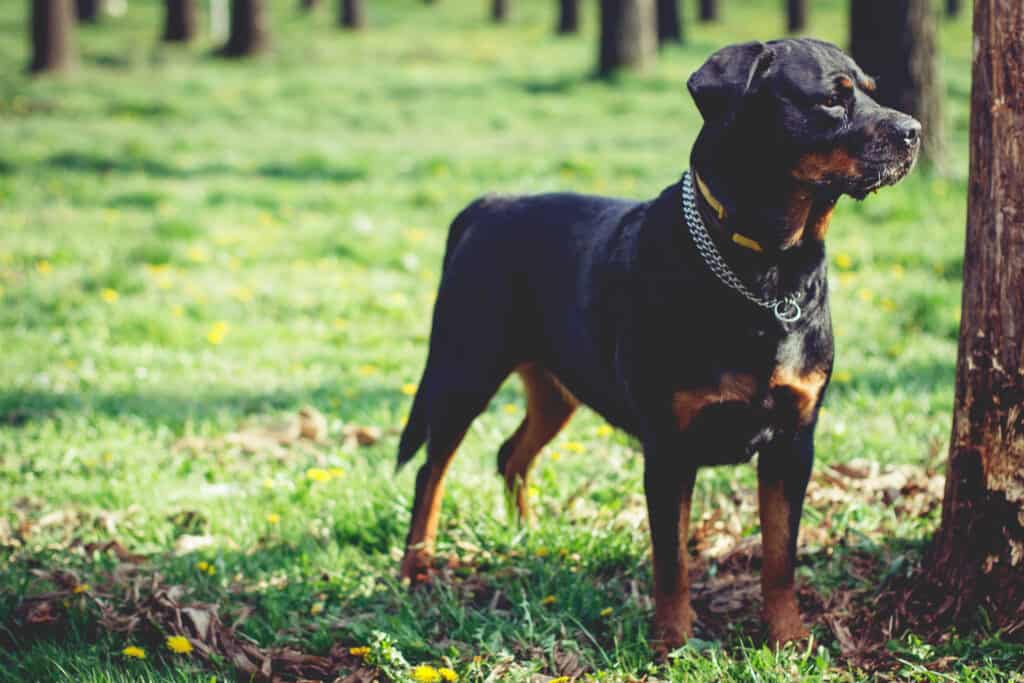
Whether you purposefully bred your Rottweiler or not, it’s your responsibility to take care of her during her transition to motherhood.
©iStock.com/maksicfoto
Rottweiler Summary
Rottweilers are a robust, powerful breed originally bred to guard meat carts. They’re extremely loyal and known for their protective qualities, even though many are bred as companions today.
While these dogs are tough, they still require careful care during pregnancy. You’ll need to ensure you give them the right diet and vet care, for instance, to help their puppies become just as tough as they are.
Rottweiler Pregnancy Symptoms
When a Rottweiler becomes pregnant, she likely won’t show any symptoms at first. Most dogs don’t act or look different for the first few weeks of pregnancy. However, your dog will eventually start to develop different signs of pregnancy.
Here are some of the most common pregnancy symptoms:
- Changes in appetite: Pregnant Rottweilers will exhibit changes in eating habits. While many think pregnant dogs eat more, some may not feel very well and eat less. It depends on the particular dog.
- Nipple enlargement: Most pregnant dogs will have nipple enlargement and darkening as their pregnancy progresses. Most of the time, this occurs later in pregnancy, but it can occur earlier, too. Dogs that have been pregnant before may have faster changes.
- Behavioral changes: Pregnant Rottweilers may start acting differently. For instance, they may be more affectionate, aloof, or restless. Every dog and pregnancy is different.
- Abdominal enlargement: Towards the end of pregnancy, your Rottweiler will have a larger stomach. However, this symptom doesn’t occur until very close to the end of pregnancy.
Gestation Period: How Long Are Rottweilers Pregnant?
All dogs are pregnant for around 63 days, including Rottweilers. However, this can vary slightly. Because their gestation is shorter than a human’s, their due date tends to vary much less. Knowing when your dog was bred will give you a very good idea of when she’ll get pregnant.
Individual Rottweilers may have slightly shorter or longer pregnancies. If your dog had a longer pregnancy previously, she will probably have a longer one again (though this can vary, too).
Be sure to monitor your Rottweiler and be prepared for these variations. It’s probably best to have the few days around your dog’s due date clear.
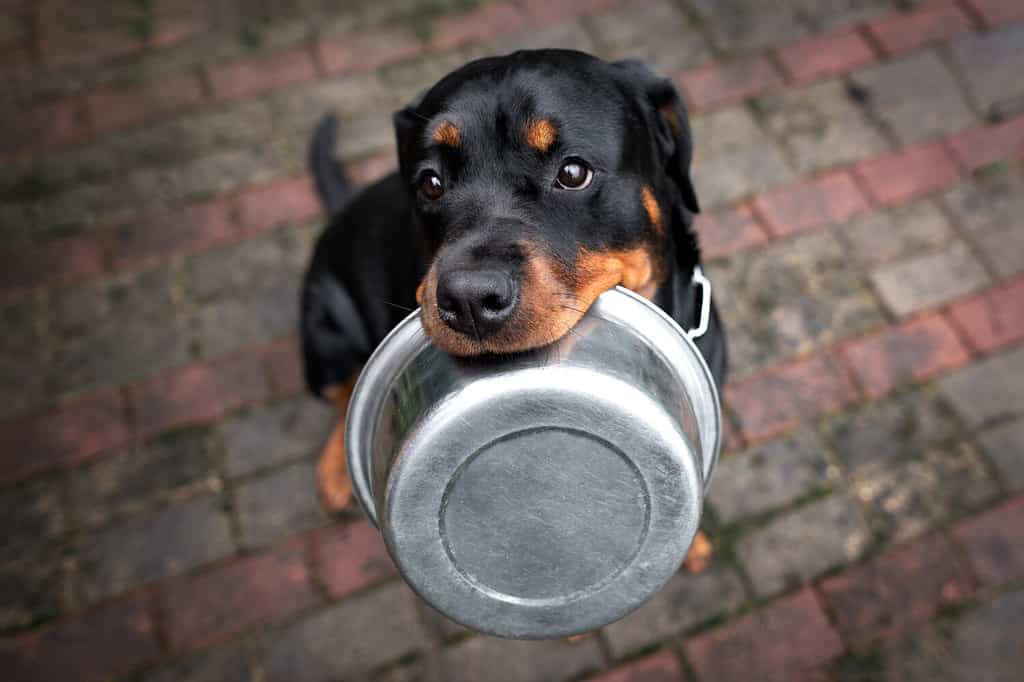
While adult dog food may have been suitable before, pregnant Rottweilers typically need to eat puppy food until they stop nursing.
©otsphoto/Shutterstock.com
Pregnancy Care for Rottweilers
Your dog must be cared for while pregnant for her and the puppies’ health. Dogs need about the same care when pregnant as they do when they aren’t pregnant. However, there are some slight differences:
Nutrition
Your dog’s nutrition differs when they are pregnant. While adult dog food may have been suitable before, pregnant Rottweilers typically need to eat puppy food until they stop nursing. Puppy food has more nutrients and is higher in calories.
However, if your dog had malnutrition beforehand, they may need more than what puppy food provides them. Speaking to your vet about their nutrition needs may be helpful.
Veterinary Care
Pregnant Rottweilers need regular veterinary visits to monitor the progression of their pregnancy. Pregnancy can have many complications; monitoring your dog allows these complications to be caught and treated early.
Your vet will provide you with exact guidelines and a schedule for visits. Often, visits increase as your dog approaches her due date.
Exercise and Rest
You should ensure your dog remains active while pregnant. Birth is a marathon; your dog must be in shape to prevent birthing complications. However, excessive physical strain isn’t recommended, and your dog will likely need more rest than before.
A very fine line must be walked here, and watching your dog is the best way to do it. Provide plenty of opportunities to exercise, but never force your dog to exercise. Later in pregnancy, for instance, you may want to eliminate walks for light exercise in your yard. Always follow your dog’s cues.
Environment
As your dog approaches her due date, you must provide a comfortable and stress-free environment. Be sure to provide a birthing box for nesting with appropriate bedding. The newspaper often works well, as many dogs like to tear things while nesting.
Dogs are especially vulnerable to stress during this period, so it’s recommended not to unnecessarily stress them out. You should avoid making big life changes while your dog is pregnant, for instance.
Average Litter Size for Rottweilers
Rottweilers are larger dogs, so they tend to have larger litter sizes compared to other breeds. You can expect a Rottweiler to have between 6 – 12 puppies. However, litter sizes can vary widely in many cases.
Often, many things determine litter size, though the breed is one large factor. For instance, the genetics of the individual dog play a role. The health of the mother (and father, to some extent) will also determine litter size. Healthier dogs often have a larger litter, as they can support more puppies.
Some dogs are simply more likely to have larger litters than others, though we may not be able to determine the exact cause.
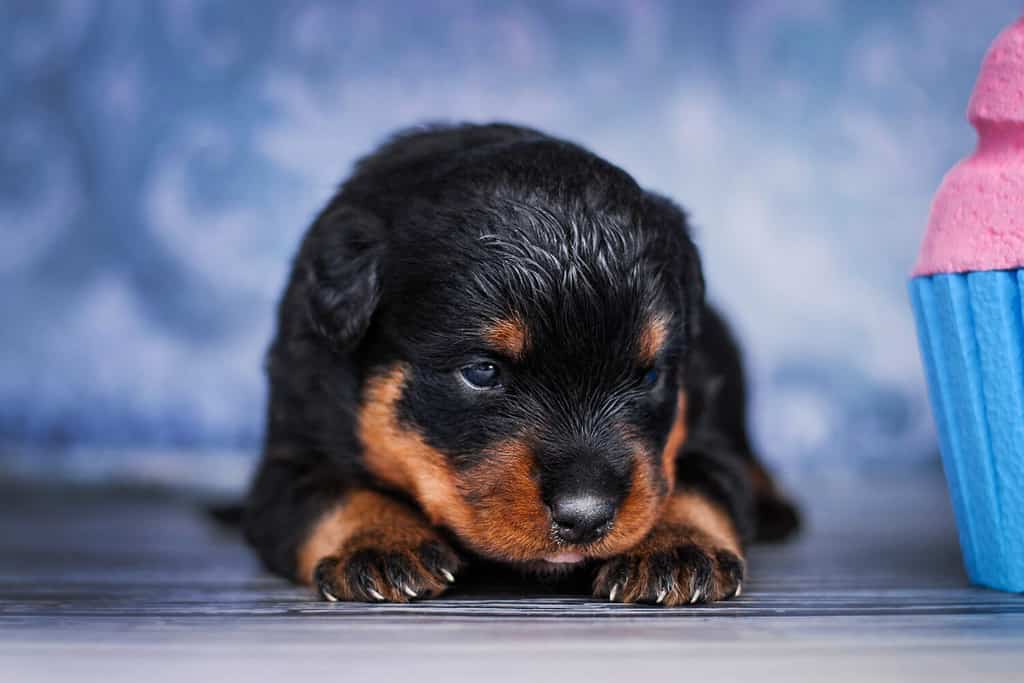
You can expect a Rottweiler to have between 6 – 12 puppies.
©Oksamutnaya/Shutterstock.com
What to Expect in Each Week of Rottweiler Pregnancy
Rottweilers are only pregnant for nine weeks, so each week holds something new. Below, we’ll provide an overview of each week and the changes you can expect to happen.
Week 1
The first week only somewhat counts as pregnancy. During this week, the eggs will travel down the dog’s fallopian tube, where they will become fertilized and then implant. Implantation doesn’t happen for a day or so after fertilization. At this point, the dog will technically become pregnant.
Because it is practically impossible to determine exactly when implantation begins, pregnancy is often measured for the date of breeding.
After implanting, the embryos start developing very quickly. However, external changes often don’t occur for at least a few more weeks. Therefore, early pregnancy isn’t known for having any symptoms, though dogs still need different nutrition and care during this time.
Week 2
The embryos continue to grow rapidly during this second week. Some very early signs may be apparent, as the dog is going through hormonal changes. However, physical signs are rare. Nipples may begin to enlarge, but it is often hard to see at this point.
Most symptoms at this stage are behavioral and due to hormone changes.
Week 3
The embryos start looking like tiny dogs and developing organs during this week. The mom’s abdomen may begin to expand, depending on her size and pregnancy history. Dogs that were previously pregnant tend to show earlier than those who are in their first pregnancy.
If you suspect that your dog is pregnant, it’s recommended that you contact your vet at this stage. The pregnancy can be confirmed, and steps are taken to prevent complications.
Week 4
By week four, the embryos will have recognizable shapes. Their limb buds, which will become legs, start to form. Their facial features are also apparent. The mother’s abdomen will continue to expand, and you may notice a small amount of weight gain.
Many Rottweilers have increased appetite during this week, as their growing puppies require more nutrition. Ensure that your dog is getting enough to eat and eating the correct food. You may also notice behavioral changes, which are driven by hormones. Many females become more affectionate, protective, or attention-seeking.
If you haven’t done it yet, now is the time for a veterinary checkup. The pregnancy needs to be confirmed, and the health of the mother needs to be monitored. Some dogs may require additional tests and supplements based on their specific needs.
Some dogs will start nesting during this week, though it will still be a while before birth. She may start seeking out a suitable spot to give birth and may become more focused on preparing the area for the arrival of the puppies. Provide a comfortable and secure whelping box where she can rest and prepare for labor.
Week 5
This week will progress similarly to the previous one. However, appetite levels may decrease, as the mother’s stomach simply isn’t as big as before. That said, some dogs may have an even bigger appetite this week. While she will need extra calories, she shouldn’t gain too much weight. Excessive weight gain can cause pregnancy complications.
The mammary glands will develop during this week, enlarging and becoming more sensitive. You may notice that her nipples are swollen, and they may start producing a milky substance as they prepare to feed the puppies.
Week 6
By week 6, the puppies’ skeletal structures are forming, and their organs are developing more. The veterinarian may be able to detect the puppies’ heartbeats during an ultrasound examination.
Your dog will become visibly round during this week. Her growing uterus and puppies will cause her abdomen to enlarge, becoming rounded. Nesting behaviors also tend to speed up around this point (if they haven’t already).
The mother’s vulva may become more swollen and relaxed in preparation for delivery. This is a normal part of the pregnancy process. Many dogs will become increasingly fatigued during this period, so don’t be surprised if your dog needs to rest more.
Regular veterinary checkups will continue during the pregnancy. Depending on the schedule, your dog may have an appointment this week.
Week 7
By week 7, the puppies’ movements become more pronounced. You may feel gentle, rhythmic movements as they shift inside the mother’s abdomen. This is an exciting time as the puppies continue to grow and develop. Your dog is pregnant.
The nesting behavior of the pregnant Rottweiler becomes more intense as she prepares for the impending birth. She may spend more time rearranging the whelping box, creating a comfortable and safe space for labor and delivery.
Most dogs will be producing colostrum by now. This rich, pre-milk substance includes antibodies to help keep the puppies safe during the first few days of their life.
As the due date approaches, finalizing your preparations for labor and delivery is crucial. Ensure the whelping box is clean, warm, and equipped with clean bedding. Have essential supplies, such as clean towels, a bulb syringe for clearing airways, and a heating pad for keeping the puppies warm.
Your Rottweiler may need more attention at this stage. Be sure to offer comfort and affection.
Week 8
Week 8 of a Rottweiler’s pregnancy is exciting as the puppies are nearing their due date. During this stage, the mother’s body and the puppies undergo final preparations for birth.
Your dog may seem uncomfortable at this stage. She will be fairly big, which contributes to the discomfort. However, dogs will also notice that they are approaching their due date, which can make them anxious. Her nesting behavior will be in full swing now.
Some pregnant Rottweilers may experience a decreased appetite as they near the end of their pregnancy. This is normal and can be attributed to the pressure on the stomach caused by the expanding uterus. Offer smaller, more frequent meals and ensure she stays hydrated.
Your dog will probably have a final vet checkup during this time. This checkup helps ensure the mother is ready to give birth and healthy. A thorough examination may be necessary, depending on the vet care your dog has received so far. An ultrasound can check on the health and number of the puppies.
The pregnant Rottweiler may experience increased vaginal discharge as she approaches labor. The discharge may be clear, mucus-like, or tinged with blood. If you notice any abnormalities or are unsure, consult your veterinarian.
Week 9
This week is the final week before labor. While due dates are often pretty accurate, you should start being on the lookout for the signs of labor as this week starts. Everything should already be prepared for. If you have any last-minute preparations, complete them in the first couple of days of this week.
Your dog’s physical changes will be in full swing. As she prepares to feed her puppies, her glands will become engorged with milk. You may notice that her nipples are large, and there may even be some leaks.
Because your Rottweiler is so very large, she’ll probably be less active and more focused. She’ll probably spend a lot of time in her chosen birthing place, which should (hopefully) be the nesting box you set up. Be sure to provide plenty of calm and peace during this week.
Dogs tend to get very restless in the 24 hours before birth. In my experience, many dogs won’t eat well, as they just can’t seem to sit still. If your dog suddenly seems like she’s hyped up on caffeine, labor is likely approaching.
How to Prepare for Labor and Delivery
You should start preparing for labor and delivery as soon as you know your dog is pregnant. This process isn’t hard or long, but your dog will start looking for a place to nest rather early. Therefore, it’s important to have the nesting box ready so she can get comfortable and nest in it.
Here are some basic steps you should do before your dog’s last couple of weeks before pregnancy.
- Create a nesting box: You should provide a comfortable, dark, quiet place for your dog to nest and give birth. The puppies should stay in this location for the first few weeks, so prepare accordingly. In the end, your dog will pick where to give birth. You’re just trying to make her pick your chosen location.
- Gather other supplies: You should have clean towels, heating pads, and un-waxed dental floss before birth begins. Hopefully, you won’t need any of these. It’s often best to let the mother take care of the puppies completely. She will clean them, bite the cord, and keep them warm. However, you never know when complications might arise, so being ready is important.
- Educate yourself: Know the common signs of impending birth and the symptoms of complications. You have eight short weeks to become an expert on your dog and birth.
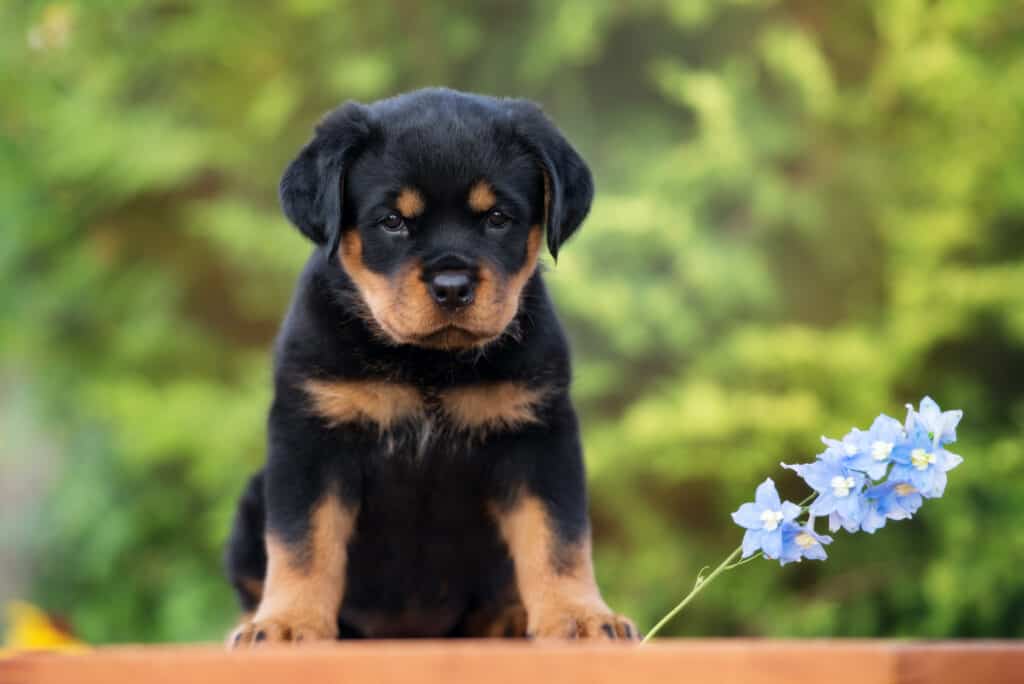
Rottweiler puppies should be walked 2-3 times a day, for 20 minutes each time.
©otsphoto/Shutterstock.com
How to Care for Your Rottweiler Afterward
Proper care after birth is very important. The hardest part is over once your dogs have survived the birthing process. However, it’s still important to help the puppies adjust to life outside the womb and encourage your dog’s mothering instincts.
Keep a close eye on the mother and puppies for the first 48 hours. Most complications will occur during this time. It’s important to catch any complications quickly to avoid disastrous endings. Once a few days have passed and the puppies are healthy, the risk of problems goes down substantially.
Be sure to provide the mother with plenty of food and water. Remember, she also makes milk for her puppies, so her hydration needs will skyrocket after birth. Plan on her drinking way more than normal.
As soon as possible, start handling and socializing the puppies. Five to ten minutes is plenty to handle all the puppies. Don’t cause unnecessary stress, but don’t leave the puppies completely alone, either. It’s a good idea to carefully examine each puppy shortly after birth to ensure they’re healthy. You can use this as handling time.
Ready to discover the top 10 cutest dog breeds in the entire world?
How about the fastest dogs, the largest dogs and those that are -- quite frankly -- just the kindest dogs on the planet? Each day, AZ Animals sends out lists just like this to our thousands of email subscribers. And the best part? It's FREE. Join today by entering your email below.
Thank you for reading! Have some feedback for us? Contact the AZ Animals editorial team.

